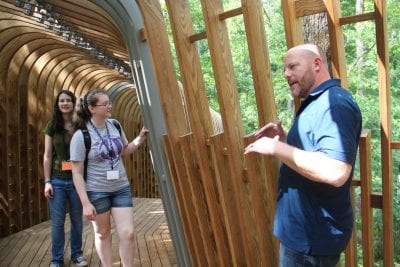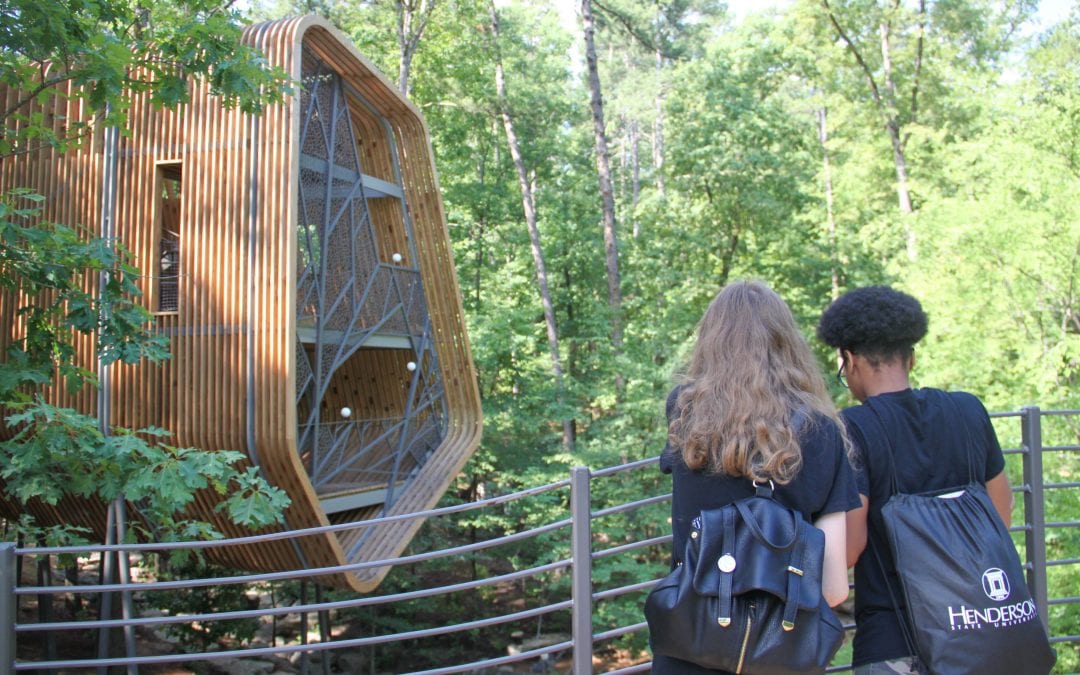By Shawnya Meyers
In June, several high school students headed to Garvan Woodland Gardens in Hot Springs to spend a week at the Fay Jones School of Architecture and Design’s summer Design Camp.
There are four Design Camps held in different parts of the state – Fayetteville, Little Rock, Hot Springs and Wilson – and at each camp the students learn about the principles of design. However, each of the camps is slightly different, with the curriculum tailored to fit the location of the camp.
Surrounded by the lush greenery of Garvan Gardens, the Design Camp in the Garden is the perfect setting for campers to learn about the importance of landscape within the design field. The garden provides many opportunities for students to experience different landscape architecture elements, and perhaps the best display of this is in the new tree house in the Evans Children’s Adventure Garden.
On the final day of Design Camp the students took an early look at the Evans Tree House, getting to explore the structure a day before it opened to the public at the garden’s Celebrate Summer event.

Josh Siebert, principal at Modus Studio, gives the Design Camp students a tour of the new tree house that was design by his firm.
Modus Studio, a Fayetteville-based firm, designed the tree house specifically for the garden. Josh Siebert, principal at Modus Studio and a Fay Jones School alumnus, gave the students a tour of the tree house, which soars 41 feet above the ground at its highest point. He told the students about the design process for the project, which was four years in the making and went through several iterations before they settled on the final design.
Siebert said the design team wanted the tree house to be mysterious and camouflaged within its environment to give children a sense of adventure as they explore the structure. The team nestled the tree house in a grove of pines and oaks, and chose materials that would help it blend in with its surroundings – 113 wooden ribs and a Venetian screen that was based on three different types of leaves.
Because the students got a sneak peek at the tree house, they were also able to see workers installing landscape elements at the site, and see firsthand the work that goes into finishing a project.
Seeing projects and talking to architects and designers helps the Design Camp students get a sense of what the design professions are about.
Keilah Barney, who just graduated from Mena High School, said she’s been interested in landscape architecture for a while, so her parents sent her to the Hot Springs camp to learn more about the profession.
“They knew I was looking into landscape architecture and thought it’d be a really good way to test the waters to see if I actually liked this,” she said.
She said that talking to people in the field shed more light on what she’d be doing on the job.
Midway through the week, the students took a field trip to Little Rock, where they looked at examples of urban design and talked with architects and designers at Polk Stanley Wilcox Architects. Students also spent the week exploring other parts of Garvan Woodland Gardens, including the Wildflower Meadow, Anthony Chapel, Garden of the Pine Wind and Celebration Garden.
Early in the week, the students went to the garden’s amphitheater on a site visit. At each camp, the students go on a site visit and create a project based on that location. For this camp, the students had to design an entrance to the garden’s amphitheater and then build a model of their plans. Landscape was especially important in this project, as the students had to create entrances that blended well with the surrounding garden.

Fay Jones School student Beau Burris shows a Design Camp student how to finish the next step in her project.
As the students worked on their projects, they got advice from Alison Turner, a clinical assistant professor of architecture in the Fay Jones School who taught the Hot Springs camp, and Beau Burris, a third-year landscape architecture student who served as a teaching assistant.
The students completed their projects in pairs, and then they presented their models in front of their families at the end of the week.
By the end of the camp, the students walked away with a better understanding of the design professions, as well as all the steps it takes to complete a project, such as planning, modeling and implementation. That experience helps the students make career choices down the road.
“I really enjoyed it so far,” Keilah said. “I feel like I might be leaning more toward landscape or architecture in general now.”

